1. U.S. Food and Drug Administration. Guidance for industry: patient-reported outcomes measures: use in medical product development to support labeling claims. Updated 2009. Accessed December 23, 2019.
https://www.fda.gov/media/77832/download.
2. Trotti A, Colevas AD, Setser A, Basch E. Patient-reported outcomes and the evolution of adverse event reporting in oncology. J Clin Oncol. 2007; 25(32):5121–5127. PMID:
17991931.

3. Chen J, Ou L, Hollis SJ. A systematic review of the impact of routine collection of patient reported outcome measures on patients, providers and health organisations in an oncologic setting. BMC Health Serv Res. 2013; 13(1):211. PMID:
23758898.

4. Howell D, Molloy S, Wilkinson K, Green E, Orchard K, Wang K, et al. Patient-reported outcomes in routine cancer clinical practice: a scoping review of use, impact on health outcomes, and implementation factors. Ann Oncol. 2015; 26(9):1846–1858. PMID:
25888610.

5. Denis F, Basch E, Septans AL, Bennouna J, Urban T, Dueck AC, et al. Two-year survival comparing web-based symptom monitoring vs routine surveillance following treatment for lung cancer. JAMA. 2019; 321(3):306–307. PMID:
30667494.

6. Ishaque S, Karnon J, Chen G, Nair R, Salter AB. A systematic review of randomised controlled trials evaluating the use of patient-reported outcome measures (PROMs). Qual Life Res. 2019; 28(3):567–592. PMID:
30284183.

7. Snyder CF, Jensen RE, Segal JB, Wu AW. Patient-reported outcomes (PROs): putting the patient perspective in patient-centered outcomes research. Med Care. 2013; 51(8):Suppl 3. S73–S79. PMID:
23774513.
8. Ahmed S, Berzon RA, Revicki DA, Lenderking WR, Moinpour CM, Basch E, et al. The use of patient-reported outcomes (PRO) within comparative effectiveness research: implications for clinical practice and health care policy. Med Care. 2012; 50(12):1060–1070. PMID:
22922434.
9. Snyder CF, Aaronson NK, Choucair AK, Elliott TE, Greenhalgh J, Halyard MY, et al. Implementing patient-reported outcomes assessment in clinical practice: a review of the options and considerations. Qual Life Res. 2012; 21(8):1305–1314. PMID:
22048932.

10. Cella D, Yount S, Rothrock N, Gershon R, Cook K, Reeve B, et al. The Patient-reported outcomes measurement information system (PROMIS): progress of an NIH Roadmap cooperative group during its first two years. Med Care. 2007; 45(5):Suppl 1. S3–11.
11. Riley WT, Rothrock N, Bruce B, Christodolou C, Cook K, Hahn EA, et al. Patient-reported outcomes measurement information system (PROMIS) domain names and definitions revisions: further evaluation of content validity in IRT-derived item banks. Qual Life Res. 2010; 19(9):1311–1321. PMID:
20593306.

12. Cella D, Riley W, Stone A, Rothrock N, Reeve B, Yount S, et al. The Patient-reported outcomes measurement information system (PROMIS) developed and tested its first wave of adult self-reported health outcome item banks: 2005–2008. J Clin Epidemiol. 2010; 63(11):1179–1194. PMID:
20685078.

13. Haan EA, Terwee CB, Van Wier MF, Willigenburg NW, Van Deurzen DF, Pisters MF, et al. Translation, cross-cultural and construct validity of the Dutch-Flemish PROMIS® upper extremity item bank v2.0. Qual Life Res. 2020; 29(4):1123–1135. PMID:
31894506.

14. Choi H, Kim C, Ko H, Park CG. Translation and validation of the Korean version of PROMIS® pediatric and parent proxy measures for emotional distress. J Patient Rep Outcomes. 2019; 3(1):36. PMID:
31222609.

15. Devine J, Schröder LA, Metzner F, Klasen F, Moon J, Herdman M, et al. Correction to: Translation and cross-cultural adaptation of eight pediatric PROMIS® item banks into Spanish and German. Qual Life Res. 2018; 27(11):3057. PMID:
30145627.

16. Westmoreland K, Reeve BB, Amuquandoh A, van der Gronde T, Manthalu O, Correia H, et al. Translation, psychometric validation, and baseline results of the Patient-Reported Outcomes Measurement Information System (PROMIS) pediatric measures to assess health-related quality of life of patients with pediatric lymphoma in Malawi. Pediatr Blood Cancer. 2018; 65(11):e27353. PMID:
30015407.

17. Devine J, Schröder LA, Metzner F, Klasen F, Moon J, Herdman M, et al. Translation and cross-cultural adaptation of eight pediatric PROMIS® item banks into Spanish and German. Qual Life Res. 2018; 27(9):2415–2430. PMID:
29766439.

18. Schnohr CW, Rasmussen CL, Langberg H, Bjørner JB. Danish translation of a physical function item bank from the Patient-Reported Outcome Measurement Information System (PROMIS). Pilot Feasibility Stud. 2017; 3(1):29. PMID:
28573045.

19. Jakob T, Nagl M, Gramm L, Heyduck K, Farin E, Glattacker M. Psychometric properties of a German translation of the PROMIS® depression item bank. Eval Health Prof. 2017; 40(1):106–120. PMID:
26272632.

20. Haverman L, Grootenhuis MA, Raat H, van Rossum MA, van Dulmen-den Broeder E, Hoppenbrouwers K, et al. Dutch-Flemish translation of nine pediatric item banks from the Patient-Reported Outcomes Measurement Information System (PROMIS)®. Qual Life Res. 2016; 25(3):761–765. PMID:
25820548.

21. Silva EC, Pinto Rde M, Mendonca TM, Silva CH. Brazilian-Portuguese translation and cultural adaptation of the sleep and wake disturbances domains of the Patient-reported-outcomes measurement information system (PROMIS). Cad Saude Publica. 2014; 30(7):1391–1401. PMID:
25166937.
22. Alves FS, Pinto RM, Mendonça TM, Silva CH. Portuguese-language translation and cross-cultural adaptation of the fatigue domain of patient-reported-outcomes measurement information system (PROMIS). Cad Saude Publica. 2014; 30(5):1103–1110. PMID:
24936825.
23. Terwee CB, Roorda LD, de Vet HC, Dekker J, Westhovens R, van Leeuwen J, et al. Dutch-Flemish translation of 17 item banks from the patient-reported outcomes measurement information system (PROMIS). Qual Life Res. 2014; 23(6):1733–1741. PMID:
24402179.

24. Bevans M, Ross A, Cella D. Patient-reported outcomes measurement information system (PROMIS): efficient, standardized tools to measure self-reported health and quality of life. Nurs Outlook. 2014; 62(5):339–345. PMID:
25015409.

25. Fischer HF, Wahl I, Nolte S, Liegl G, Brähler E, Löwe B, et al. Language-related differential item functioning between English and German PROMIS depression items is negligible. Int J Methods Psychiatr Res. 2017; 26(4):e1530.

26. Choi JS, Park YS, Kim JA, Park CS. International trends on patient-reported outcome measures for improving care quality and its implication for South Korea: focus on OECD PaRIS. Qual Improv Health Care. 2019; 25(1):11–28.

27. Bonomi AE, Cella DF, Hahn EA, Bjordal K, Sperner-Unterweger B, Gangeri L, et al. Multilingual translation of the functional assessment of cancer therapy (FACT) quality of life measurement system. Qual Life Res. 1996; 5(3):309–320. PMID:
8763799.

28. Eremenco SL, Cella D, Arnold BJ. A comprehensive method for the translation and cross-cultural validation of health status questionnaires. Eval Health Prof. 2005; 28(2):212–232. PMID:
15851774.

29. Willis GB. Cognitive Interviewing: a Tool for Improving Questionnaire Design. New York, NY, USA: SAGE Publications;2004.
30. Solorio R, Ayala NC, Paez E, Skalicky AM, Morales LS. Use of cognitive interviews to adapt PROMIS measurement items for Spanish speakers living with HIV. Aids Res Treat. 2016; 2016:8340863. PMID:
27022480.

31. Christodoulou C, Junghaenel DU, DeWalt DA, Rothrock N, Stone AA. Cognitive interviewing in the evaluation of fatigue items: results from the patient-reported outcomes measurement information system (PROMIS). Qual Life Res. 2008; 17(10):1239–1246. PMID:
18850327.

32. Liegl G, Rose M, Correia H, Fischer HF, Kanlidere S, Mierke A, et al. An initial psychometric evaluation of the German PROMIS v1.2 physical function item bank in patients with a wide range of health conditions. Clin Rehabil. 2018; 32(1):84–93. PMID:
28604084.

33. Liu Y, Hinds PS, Wang J, Correia H, Du S, Ding J, et al. Translation and linguistic validation of the pediatric patient-reported outcomes measurement information system measures into simplified Chinese using cognitive interviewing methodology. Cancer Nurs. 2013; 36(5):368–376. PMID:
23860394.

34. Mahmoud GA, Rady HM, Mostafa AM. Cross cultural adaptation and validation of an Arabic version of selected PROMIS measures for use in rheumatoid arthritis patients. Egypt Rheumatol. 2019; 41(3):177–182.

35. Rhee Y, Jun S, Choi SE. Concepts and applications of patient-reported outcomes & quality of life measure: practical recommendations for Korea. J Health Technol Assess. 2015; 3(1):48–58.
36. Cho J, Yoon J, Kim Y, Park S. Development and Clinical Validation of Patient-Reported Outcome Measurements for Chronic Disease Patients for Precision Medicine. Cheongju, Korea: Korea Ministry of Food and Drug Safety;2018.
37. Oude Voshaar MA, Ten Klooster PM, Taal E, Krishnan E, van de Laar MA. Dutch translation and cross-cultural adaptation of the PROMIS® physical function item bank and cognitive pre-test in Dutch arthritis patients. Arthritis Res Ther. 2012; 14(2):R47. PMID:
22390734.

38. Bae JM. Indices for the responsiveness and interpretability in patient-reported outcomes. Korean J Fam Pract. 2015; 5(3):161–166.
39. Cho J, Yoon J, Kim Y, Oh D, Kim SJ, Ahn J, et al. Linguistic validation of the US national cancer institute's patient-reported outcomes version of the common terminology criteria for adverse events in Korean. J Glob Oncol. 2019; 5(5):1–10.

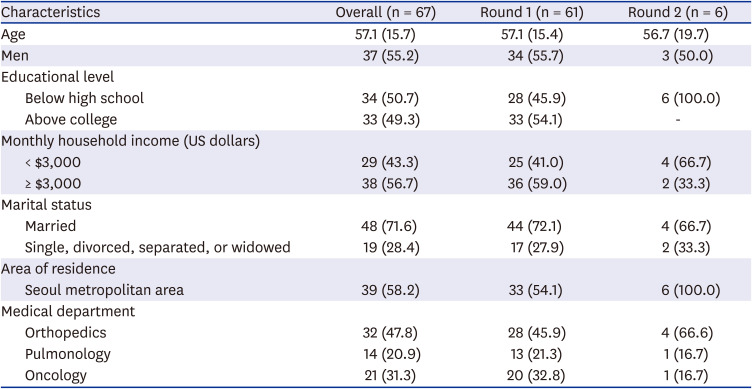

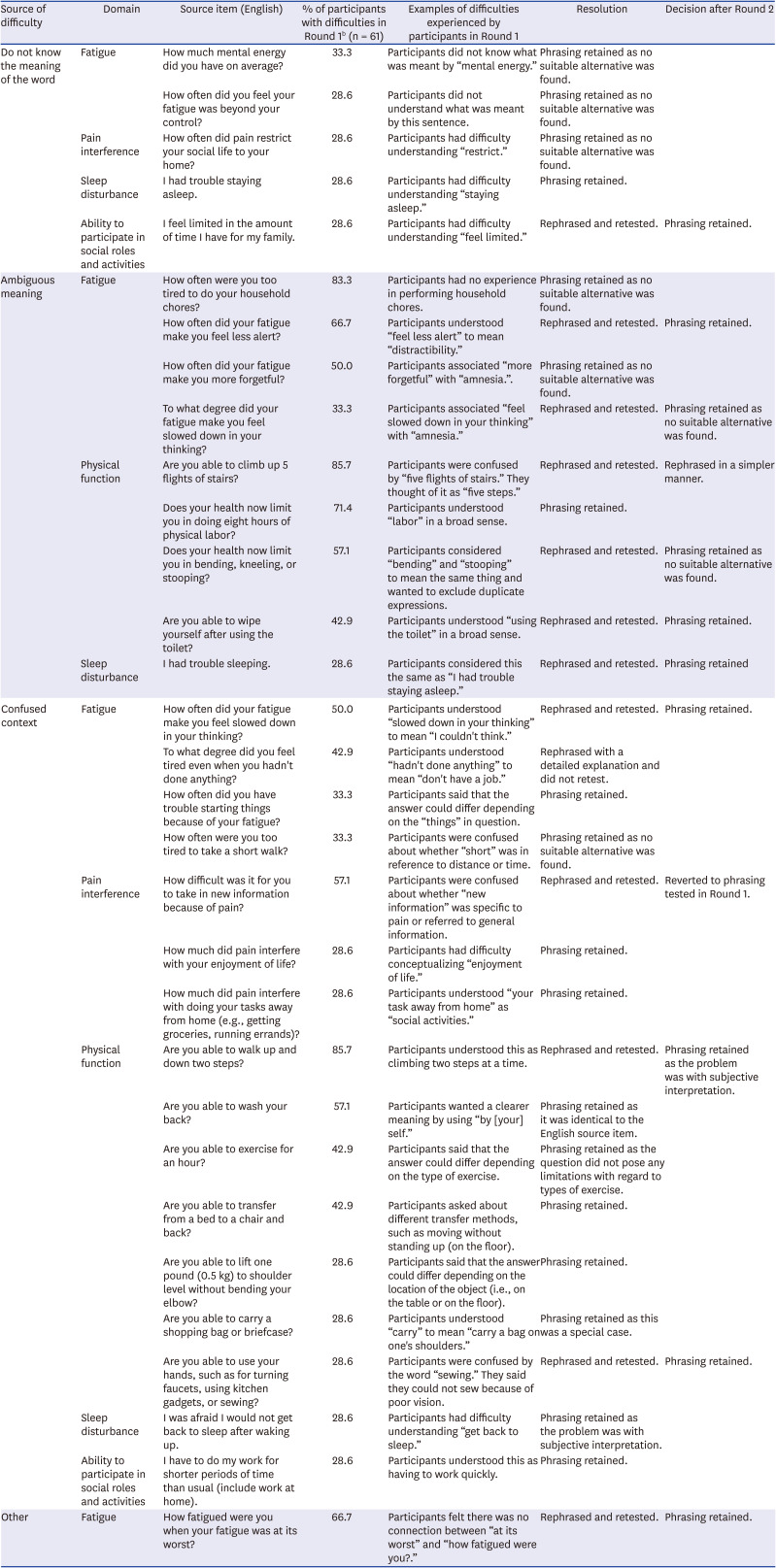
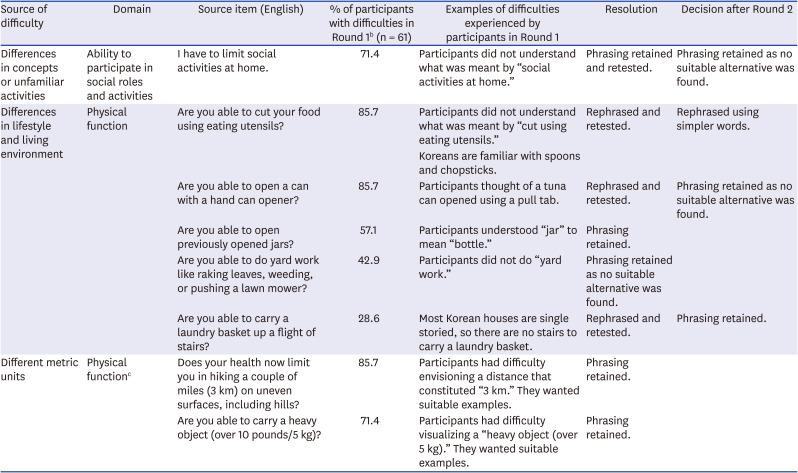




 PDF
PDF Citation
Citation Print
Print



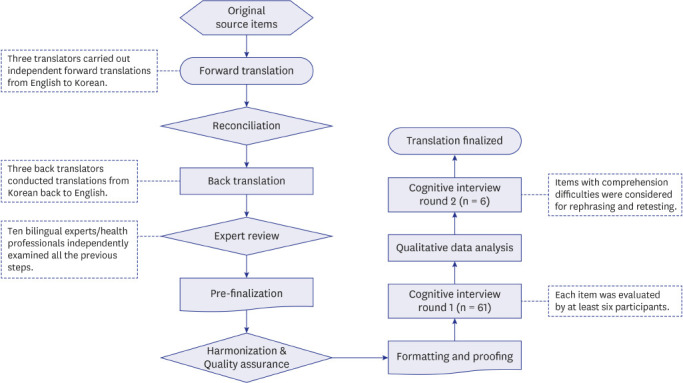
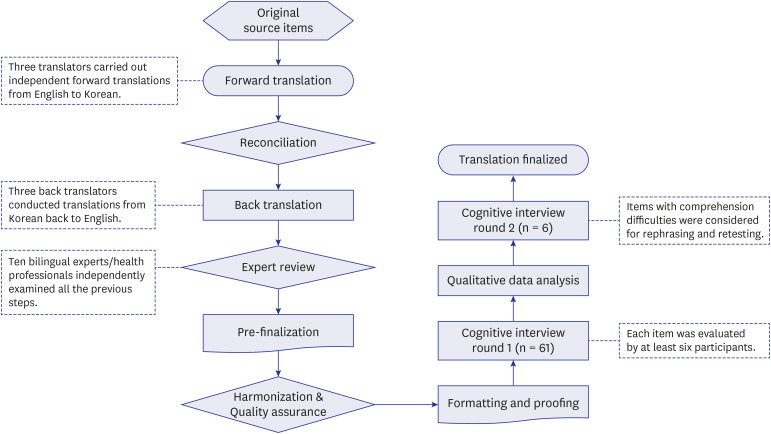
 XML Download
XML Download